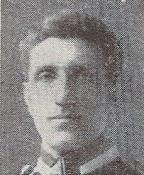
War Memorial
| Lieutenant William John Wall FLETCHER RN | |
|
HMS Black Prince, Royal Navy Date of birth: 21st August 1883 Date of death: 31st May 1916 Killed in action aged 32 Commemorated on the Portsmouth Naval Memorial Panel 11 |

|
| William John Wall Fletcher was born at St Marychurch, Torquay on the 21st of August 1883 the only son of William Fletcher and Louisa Alberta (nee Elson) Fletcher of 1 Carlton Place, St Marychurch, Torquay. He was educated at Hazelwood School until December 1895 when he went on to the Britannia Naval College and entered the Navy on the 20th of January 1899 with the rank of Boy 2nd Class. At a medical examination, it was recorded that he was 5 feet six and three quarter inches tall and that he had light brown hair, dark blue eyes and a fresh complexion. He was posted to the training ship HMS Lion on the 25th of January and was promoted to Boy 1st Class on the 31st of August 1899. On completion of his training he was posted to the ironclad frigate HMS Agincourt on the 21st of March 1900. On the11th of April 1900 he was posted to the cruiser HMS Highflyer and was promoted to Ordinary Seaman on the 21st of August 1901. He was promoted to Able Seaman on the 20th of March 1902. From the 25th of November 1903 he served with the base ship HMS Vivid at Devonport and he transferred to the gunnery training ship HMS Cambridge at the Royal Naval Barracks, Devonport on the 10th of April 1904. He was promoted to Leading Seaman on the 7th of December 1904 and to Petty Officer 2nd Class on the 4th of April 1905. He joined the crew of the cruiser HMS Suffolk on the 10th of April 1906 and was promoted to Petty Officer 1st Class on the 21st of June 1906. He underwent a gunnery course at Devonport and passed with a 1st Certificate on the 1st of September 1906. He returned to HMS Cambridge from the 9th of November 1906 and to HMS Vivid I from the 5th of November 1907. On the 1st of March 1908 he joined the Royal Naval Torpedo School, HMS Defiance before re-joining HMS Vivid I on the 2nd of June 1908. On the 14th of September 1908 he joined the crew of the cruiser HMS Doris and served with her until the 23rd of May 1910. He was appointed as Acting Gunner on the 24th of May 1910, which was confirmed on the 24th of May 1911. On the 17th of June 1910 he joined the crew of the battleship HMS Hannibal and on the 15th of December 1910 he was posted to the battleship HMS Queen. From the 13th of March 1911 he was posted to HMS Excellent I, the Royal Naval Gunnery School based at Whale Island, Portsmouth for an advanced gunnery course, where he was described as "Very zealous and capable, good physical qualities". He passed out on the 20th of December 1911. He was posted to the battleship HMS Orion for instructional duties from the 13th of January 1912 and was sent for training as a Mate on the 19th of October 1912. He was promoted to Acting Mate on the 14th of February 1913 and was sent on a course at Greenwich on the 16th of February 1913. On the 1st July 1913 he joined the navigation school ship HMS Druid and on the 29th November 1913 he joined the crew of the armoured cruiser HMS Black Price as Mate. He was commissioned as an Acting Lieutenant in the Royal Navy on the 14th of February 1915. He was married in South London on the 26th of November 1915 to Ethel Rebecca (nee Miller) ; they lived at 14 Old Devonshire Road, Balham in South London. He applied for promotion to Gunnery Lieutenant and a note on his file dated the 26th of January 1916 reads: - "Would make a very good Gunnery Lieutenant. Able, well educated and hardworking and has had scores of years experience of the practical side of gunnery. A suitable officer in all respects and strongly recommend his application." Another officer responded to these remarks on the 30th of January 1916: - "As this officer has important duties in action it is submitted that this application may not be considered until after the school." On the night of the 30th of May 1916 HMS Black Prince, under the command of Captain Thomas Parry Bonham RN, was part of 1st Cruiser Squadron at the Battle of Jutland. She was part of the screening force for the fleet when she became separated from the main fleet. She attacked the German battleship Rheinland at 11.35pm, scoring two hits with her six inch guns. At around midnight she saw a line of ships half a mile away, which she most probably took to be Royal Navy vessels as she altered course towards them. As she approached the ships the German recognition signal was given and Bonham, realising his mistake, swung the cruiser away from them. She had strayed into the path of the German Grand Fleet and was lit up by searchlights and, at a range of 1,000 yards, was attacked with torpedoes, and was raked from bow to stern with shell fire by the enemy battleships Thuringen, Ostfriesland, Friedrich der Grosse and Nassau. Being in no position to defend herself against such huge odds she did not have time to fire a shot in reply as she was hit by an estimated fifty shells in less than a minute. She was soon set ablaze and sank at 12.10am on the 1st of June, just fifteen minutes after she had come under fire. Cadet Heinz Bonatz a crew member of the Nassau was a witness to the sinking: - “We suddenly sighted a cruiser with four funnels, HMS Black Prince. It immediately came under fire from three other ships. Within minutes the cruiser was a glowing wreck and sank after a mighty explosion, a horrible and imposing sight.” Admiral Reinhard Scheer on the Friedrich der Grosse also saw the sinking: - “In a few seconds she was on fire, and sank with a terrible explosion four minutes after opening fire. The destruction of this vessel, which was so near that the crew could be seen rushing backwards and forwards on the burning deck while the searchlights disclosed the flight of the heavy projectiles till they fell and exploded, was a grand and terrible sight.” HMS Black Prince sank with the loss of her entire crew of eight hundred and fifty seven men. |
|
| Went on to Britannia Naval Coll |
Back